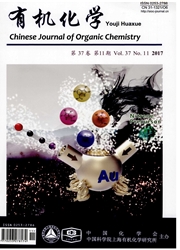

 中文摘要:
中文摘要:
通过胺基锂盐分离的方法合成了一种未有报道过的N-四氢糠基PNP配体E.E分别与Cr Cl3(THF)3和Cr(CO)6反应生成化合物[{Ph2PN(CH2OC4H7)PPh2}Cr Cl2(μ-Cl)]2(1)和[Ph2PN(CH2OC4H7)PPh2]Cr(CO)4(2).这三个化合物通过谱学和元素分析表征,化合物2进一步经过X射线单晶结构确认.在甲基铝氧烷(MAO)或其它助剂作用下,考察了1、2以及E/Cr Cl3(THF)3、E/Cr(acac)3、E/Cr Cl2(THF)2催化体系催化乙烯齐聚的性能.这些体系高选择性地催化乙烯四聚,最高活性为15.9 kg(product)/g(Cr)·h,1-辛烯的选择性最高可达63.6%.
 英文摘要:
英文摘要:
The N-tetrahydrofurfuryl diphoshinoamine(PNP) ligand(E) was synthesized by means of two-step salt elimination reactions where separation of the two kinds of the aminyl lithium salts for the respective reactions is necessary for obtaining a high yield of E. The ligand reacted with Cr Cl3(THF)3 and Cr(CO)6 to give P,P-chelation complexes [{Ph2PN(CH2OC4H7)-PPh2}Cr Cl2(μ-Cl)]2(1) and [Ph2PN(CH2OC4H7)PPh2]Cr(CO)4(2), respectively. Complexes E, 1 and 2 were characterized by spectroscopy and elemental analysis, of which complex 2 was further confirmed by X-ray crystallography. Upon activation with methylaluminoxane(MAO) or Al Et3, the catalyst systems including 1, 2, E/Cr Cl3(THF)3, E/Cr(acac)3 and E/Cr Cl2(THF)2were investigated. The best catalytic activity was achieved by 15.9 kg(product)/g(Cr)·h in which a selectivity of 63.6% for 1-C8 was obtained.
 同期刊论文项目
同期刊论文项目
 同项目期刊论文
同项目期刊论文
 期刊信息
期刊信息
